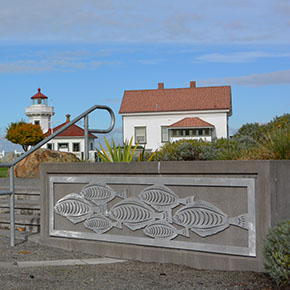 It is fitting that the final stop of the walking tour returns us to the original inhabitants of this area. Once again we see the Native American symbols of Orcas and salmon carved into the sidewalks and planters. What may not be as noticeable is how the design of the nearby buildings reflects the architecture of the traditional longhouses used by the Lushootseed. Lushootseed culture has often been overshadowed by the “totem pole cultures” of the coast further north into Canada and Alaska and the “tipi” cultures of the Great Plains. But as the Tulalip Tribes today pursue further research into their past, the richness of their cultural legacy is increasingly revealed.
It is fitting that the final stop of the walking tour returns us to the original inhabitants of this area. Once again we see the Native American symbols of Orcas and salmon carved into the sidewalks and planters. What may not be as noticeable is how the design of the nearby buildings reflects the architecture of the traditional longhouses used by the Lushootseed. Lushootseed culture has often been overshadowed by the “totem pole cultures” of the coast further north into Canada and Alaska and the “tipi” cultures of the Great Plains. But as the Tulalip Tribes today pursue further research into their past, the richness of their cultural legacy is increasingly revealed.
For example, what may be seen by some as simply a large dwelling is remembered by Native Americans as the center of their lives and community. More than simply shelter, Lushootseed houses reflected relationships among people. The owners of the house, who led most day-to-day and ceremonial tasks, had their fire in a front corner away from doorway drafts. Common people had hearths along the sides and back, while slaves, captured from neighboring communities, found space where they could.
What is fascinating is the way in which the Lushootseed language reveals the integrative nature of their worldview. The frame of the longhouse was seen as a body on its hands and knees, with the front of the house, as portrayed here by the large opening of the performance stage, being called the face. Words for human skin, house walls, canoe hulls, and the edge of the world were the same or very similar. The roof ridge of a house was imagined as a spine, a river, and the Milky Way. Cedar posts holding up the roof, painted or carved with the power spirits of the leading family, were described both as human limbs and as pillars supporting the sky. Within this universe, cleaning a house, bailing a canoe, and curing an illness were all ways to maintain the universe.
Copyright 2015, Mukilteo Walking Tour. All rights reserved.